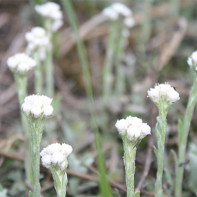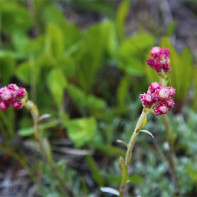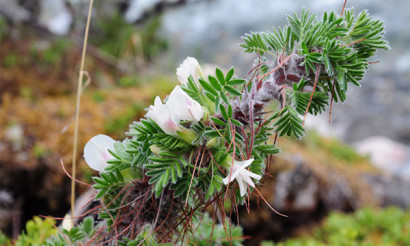Cat's foot: medicinal properties and contraindications
It is not by chance that the antenna is popularly called the cat's paw. Firstly, the flower bud of the plant externally really resembles the foot of a pet. The second explanation of this name is connected with the legend according to which a homeless cat saved a sick child by bringing unknown grass to the house. The hostess prepared a decoction from this plant and watered the child with it. Soon the baby recovered, and since then the wonderful grass has since been called the "cat's foot".
- Chemical composition
- How it looks and where it grows
- Areas of growth
- Views
- Collection and storage
- The healing properties of a cat's paw
- Cat's foot in folk medicine
- Eye Disease Treatment
- Hemostatic infusion
- Liver broth
- Douching
- Tincture for the treatment of mastopathy
- Gargle
- Soothing broth
- Remedy for eye diseases
- Types of healing compounds
- Infusion
- Tincture
- Decoction
- Contraindications
There is a great deal of truth to this mythical story. In Russia, a medicinal plant was widely used as an effective hemostatic agent. With the help of herbs they eliminated intestinal problems and cured. Folk healers claimed that the mysterious grass is able to heal a person from hundreds of diseases. In the official directory of medicinal plants, antennaria, unfortunately, is not listed. But since ancient times, unique recipes with the participation of this plant have been preserved and are widely used today in home therapy. Cat's paws are a very healthy herb. She deserves to tell you more about her unique composition and healing properties.
Chemical composition
The cat's paw in its composition contains a full-fledged complex of nutrients and chemical compounds that provide a number of medicinal properties. The main part of the components is concentrated in the ground part of the plant. The following active elements are present in the grass:
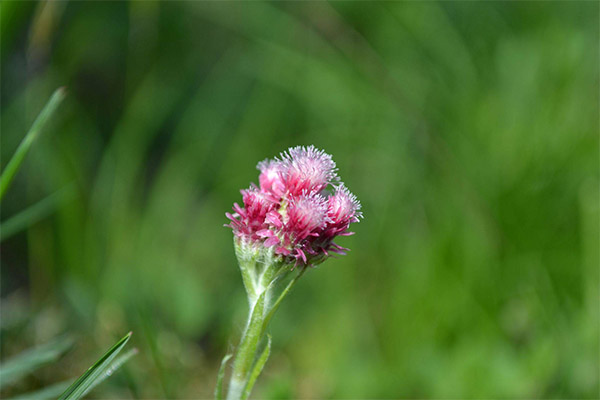
- Tannins cleanse the body of toxins and free radicals, exhibit anti-inflammatory properties, and stimulate digestion.
- Ascorbic acid (or well-known vitamin C) reduces the concentration of uric acid, strengthens the immune forces, participates in the synthesis of important hormones, and regulates cellular respiration.
- Resins have antiseptic properties, promote wound healing, and inhibit the development of putrefactive processes in the intestine.
- Vitamin K is a whole group of substances that regulate the composition of the blood. In particular, this substance contributes to the production of prothrombin, an enzyme that provides blood coagulation.
- Saponins localize the foci of inflammation, normalize the water-salt balance. This group of substances also stimulates the production of some important hormones.
- Phytosterols have a detrimental effect on viruses and bacteria, neutralize toxins, and participate in the synthesis of hormones.
- Essential oils have a positive effect on the functioning of the cardiovascular system, improve the digestive tract, and exhibit anti-inflammatory activity.
- Alkaloids normalize blood pressure, relieve pain, have a definite effect on the central nervous system (large doses of the drug inhibit it, and small ones cause severe excitement).
In addition to these components, the plant contains many other substances that are beneficial to human health. And although antennaria is not included in the register of essential drugs, professional doctors do not deny its healing abilities. Herbalists always procure raw materials for the future, in order to subsequently prepare medicinal formulations for home therapy.
How it looks and where it grows
The cat's foot does not differ in attractive appearance and bright beautiful inflorescences. This dioecious plant, belonging to the family of Astrovidae (Compositae) and the genus of Cat's feet, looks modest. The main characteristics of the perennial:
- Height. An adult plant reaches a height of not more than 30 cm.The dwarfism of antennaria is explained by its resistance to high temperatures, which, however, is characteristic of all heat-tolerant plants.
- The stems are protected by a fleecy cover. Therefore, the grass is not afraid of drought, and also easily tolerates 30-degree frosts.
- The bright green leaves of the culture from the outside are perfectly smooth, and their lower part is rough, with a silver tint. The main part of the foliage is collected near the ground in a socket.
- The thin root of the cat's foot is divided into many branches, due to which the plant is firmly fixed in the ground.
- Small flowers form an inflorescence-basket, resembling the shape of a cat's paw. They are as soft and velvety as pets. Male inflorescences are distinguished by a white tint, but they have a more rough shape than pale pink women's baskets.
- The fruit is oblong. It resembles a cylinder and is complemented by a fleecy crest.
It is interesting: cat's foot blooms only when the stalk is stretched 25 cm in height.
Areas of growth
Antennaria is one of the most widespread species of wild vegetation on the planet. This representative of the flora, like a universal soldier, is not afraid of either heat or cold. Having natural protection in the form of a felt cover, the grass is able to accumulate and preserve water resources. Favorite places for settlement are sunny forest glades, fields, meadows, highlands. An abundance of light is the main condition for a comfortable plant life. Therefore, if you want to find healing grass, you should always focus on open spaces.
You can meet a cat's paw in almost all Russian regions. Grass feels great in Japan and North America. It occupies large territories in Kazakhstan and the Kuril Islands. Even in the foothills of the Caucasus and the northern tundra, it is not difficult to find this plain-looking, but very useful plant. The grass adapts well to the most severe conditions of existence. Some types of antennae complement the scarce landscape of the Arctic regions.
Good to know: if you put a cat's foot in fertile soil, the grass quickly stretches up, losing its natural compactness.
Views
The people endowed the cat's paw with more than a dozen bright names. Therefore, it is often difficult to determine the species affiliation. For example, often antennaria is called "breast grass" for the ability to cure a cough, it is known by the name "white immortelle." But with a sandy immortelle, which is easily recognizable by bright yellow inflorescences, the cat's foot has nothing to do. And the people gave this name to the healing grass because in dried form it does not lose the freshness of the freshly picked plant. Nicknames such as scrofula, goryanka, and Kamchuk are also common.
Nerds find it difficult to name the exact number of species of cat's feet. Some scientists claim that there are more than 100 of them, but only 50 varieties of grass are described in the handbook. Only 10 species are distributed on Russian territory, and almost all of them live in the Arctic zone. The plant is protected by law, so there are types of antennaria listed in the Red Book.
Among the frequently encountered species can be noted:
- The cat's foot is dioecious - the most common variety that herbalists harvest for medicinal purposes. Flowering time - May-June.
- The Carpathian species differs from the dioecious species in that it completely lacks the deciduous cover of the peduncle. The habitat of the cat's paw of this species is the Carpathians.
- Alpine variety grows in northern Europe. The flower stalk reaches growth up to 25 cm, and small grayish-green leaves - up to 5 cm. The flowering period is from July to August.
- An ordinary cat's foot is a dwarf species whose height does not exceed 10 cm. The flowering period coincides with the middle of summer. The color of the inflorescences varies from snow-white to deep red tones.
- Plantain species is found mainly in the regions of North America. This variety is distinguished by a high (up to 40 cm) peduncle and large leaves resembling plantain.
- The large-leafed (sunny) cat's foot is also found mainly in North America. Very thermophilic low plant with large leaves and white inflorescences.
- The fluffy species is a representative of the Arctic flora. Small plant with very narrow leaves, only 1 cm wide.
It is interesting: in the old days, in honor of the mythical plant, the nekuy-wind cat's foot was often called the "neuvuyevik". According to ancient folk tales, this weed helped to find treasures for blind people.
Collection and storage
When used correctly, a cat's foot will help cure a huge number of diseases. Simple formulations based on it will improve the condition even with chronic pathologies, and will also help prevent the development of serious disorders. But for medicinal purposes, only the ground parts of the grass are used, that is, foliage, inflorescences and fruits. Therefore, the valuable material can be harvested starting from the time of flowering, that is, from the beginning of May to the end of August, when the fruits ripen. It’s worth noting right away that you can’t buy ready-made cat paw raw materials in a pharmacy. Usually, such medicinal herbs are sold in drugstores of folk herbalists, as well as in shops at monasteries.
The rules for collecting plant material are simple:
- Stems, foliage, flowers need to be collected at the height of flowering. You can also shoot inflorescences during budding. At these stages, the grass is saturated with the most useful components.
- The collected raw materials must be cleaned of extraneous debris, sorted and laid out for drying under a canopy. You can store the blank and use it for three years.
- It is also allowed to collect inflorescences even before the baskets open, but then their shelf life is reduced to a year.
For long-term storage, well-dried material should be distributed in paper bags or cardboard boxes.
For storage, medicinal raw materials must be determined in a cool but dry room.
Attention: Cat's foot grass should not be exposed to hot drying methods.
The healing properties of a cat's paw
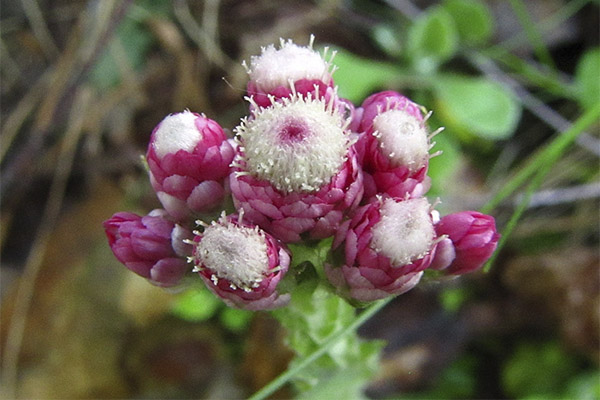
People unfamiliar with the cat's paw are usually surprised when they find out about her incredible healing abilities. It is no coincidence that many healers say that a whole pharmacy warehouse is concentrated in a small unattractive plant. And such a comparison cannot be considered an exaggeration, since antennaria successfully copes with a variety of diseases and ailments. It is especially highly valued in gynecological practice, as it quickly stops uterine bleeding. In addition to hemostatic properties, perennial is also characterized by the following therapeutic actions:
- wound healing;
- antispasmodic;
- antiseptic;
- painkillers;
- sedative;
- anti-inflammatory;
- diuretic;
- expectorant;
- choleretic;
- antitumor;
- vasodilator.
All these therapeutic effects are fully manifested during the administration of simple dosage forms prepared from this medicinal plant.
What pathologies will cat's foot grass help with?
Since potentially hazardous components such as alkaloids are present in the plant, it is worth consulting a doctor before using drugs prepared according to traditional recipes. Usually, professional doctors willingly supplement the complex of treatment with herbal preparations.
The cat’s foot can be considered a universal medicine, because formulations based on this wonderful herb help in the treatment of the following pathological conditions:
- hypertension
- cholecystitis;
- hemorrhoids;
- bleeding of various origins;
- skin diseases;
- tuberculosis;
- inflammatory diseases of the respiratory tract;
- hernia;
- whooping cough;
- hepatitis;
- exudative diathesis in children;
- open wounds;
- menstrual irregularities;
- peptic ulcer;
- glaucoma and other eye diseases;
- diseases of the female genital organs;
- stomatitis and gingivitis;
- diarrhea;
- venereal diseases;
- gout and many more other diseases.
The plant is especially in demand in gastroenterology and gynecology, because almost any problems can be solved with the participation of healing herbs. Scientists have thoroughly researched dioecious antennaria and have proven in practical ways that the plant has high anticarcinogenic activity. Therefore, preparations with a cat's foot can serve as an effective prevention against cancer.
Cat's foot in folk medicine
Over the centuries-old practice in folk medicine, vast experience has been gained in treating herbs of various diseases, from gastric colic to severe oncological processes. Therefore, herbalists and healers are well aware of how to properly work with plant material so that it does not lose its value.
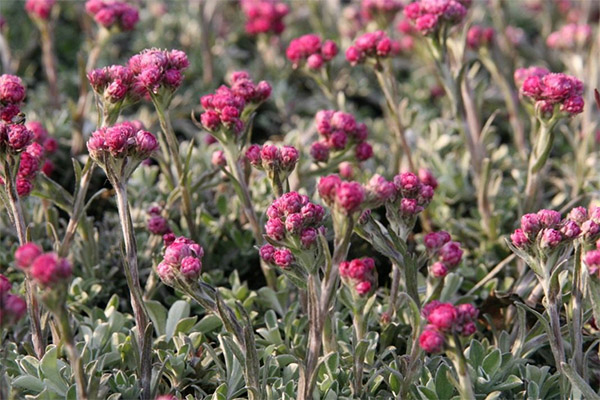
It’s easy to make cat paw formulations. The reference book of traditional medicine contains simple and complex recipes using this useful plant. There are universal remedies that can be used for various pathologies. But there is one caveat that you should definitely remember. For the treatment of various diseases, different parts of the plant should be used.
Stalks and leaves. From these parts of the neck of the neck you can prepare medicines for oral administration for any type of bleeding. Such solutions are used for external processing and douching, for example, with gonorrhea. It is recommended to sprinkle with dried grass powder for better healing of wounds and burn surfaces.
Dried inflorescences are suitable for the treatment of intestinal and gastric problems. Decoctions and infusions improve liver function, destroy stones in the bile ducts, and help with hepatitis of any type.
After getting acquainted with the characteristics of the healing plant, you can begin to review the most popular recipes.
Eye Disease Treatment
This extremely simple method of therapy will help improve vision and cataract and glaucoma. The procedure is to place a few flowers in a canvas bag, and then soak it all in boiling water. Such a compress should be applied to sore eyes daily before bedtime.
Hemostatic infusion
This recipe is relevant for uterine bleeding or heavy periods. The solution is prepared based on: for 100 ml of boiling water - 1 tbsp. grassy part of cat's legs. After combining the two components, the solution should be infused for at least half an hour, then it should be filtered. Take medicine with severe bleeding every hour for 1 tbsp.
The tool can be used for tampons.
A decoction of leaves and baskets of antennaria will also help stop bleeding of any genesis.
To do this, you must:
- First mix 10 g of dried flowers and leaves, and then pour the plant mixture into a glass of boiling water.
- Put the dishes with the resulting composition on low heat.
- Boil the mixture for a quarter of an hour.
- When the solution cools down, it is good to filter it.
- Bring the volume to its original level by adding distilled water.
Take a decoction for bleeding for 1 tbsp. The multiplicity of receptions depends on the intensity of blood loss.
Note: the broth prepared according to this recipe is recommended for compresses in the treatment of skin rashes.
Liver broth
This tool can be drunk with liver problems and impaired gallbladder function. Cooking is best in a thermos. Proportions of components: 2 tbsp. dried flowers you need to take a glass of boiling water. After combining the ingredients, close the thermos with a stopper.Shake the infusion for several half an hour, then pour the mixture into an enameled pan and put on low heat. Boil the composition for 5-7 minutes, then remove from the stove and cool. Before use, strain the broth. Drink 1 tablespoon three times a day before meals. The course of such treatment is 10 days, but if necessary, continue therapy, you need to take a week pause.
Douching
Professional gynecologists recommend this method of treatment for vaginitis and acute colpitis in women. For the douching procedure, you need to prepare a decoction according to the standard scheme: 2 tbsp. aerials herbs in a glass of water. Before use, bring the volume of liquid to a liter. Procedures should be carried out in the acute course of the inflammatory process twice a day. Instead of douching, swabs moistened with a solution can be introduced into the vagina.
Tincture for the treatment of mastopathy
The following ingredients are part of this complex collection:
- dry red wine - 0.6 l;
- St. John's wort (inflorescences) - 2 tablespoons;
- nettle leaves - 1 tbsp;
- aloe juice - 180 ml;
- snake highlander (roots crushed into powder) - 2-3 tbsp;
- cat's foot (flower baskets) - 2 tbsp .;
- honey - 600 g.
Algorithm for preparing tinctures:
- First, combine all herbal ingredients in a container.
- Pour the base with wine, add honey.
- Put the mixture in a water bath, with thorough stirring, keep it there for two hours.
- After removing from heat, allow the composition to cool slightly, and then filter the tincture.
You can take a medicine for mastopathy 2-3 times in 30 drops.
The duration of the course of therapy depends on the dynamics of the pathological process. But as practice shows, after the first days of use, the condition of patients improves markedly.
Gargle
This recipe can be considered universal, since it is suitable not only for the treatment of tonsillitis, but also relieves the symptoms of inflammation in stomatitis.
The method of preparing the infusion is simple: for one part of the plant material you need to take 5 parts of water. Bring the liquid base to a boil, and then pour grass over it. Infuse the solution for an hour. Rinsing the throat and oral cavity is recommended several times a day. This infusion is suitable for compresses for rashes and open wounds on the surface of the skin.
Soothing broth
To prepare this tool, you will need to take a glass of water and 10 g of dry flowers of the scrofula. Place vegetable raw materials in a container, fill it with water, put on a slow fire. The broth should boil no more than 5 minutes. Then let it brew, and after half an hour the solution can be filtered.
Treatment is carried out according to the following scheme:
- On the first day, drink 1/4 cup in the morning before meals.
- On the second day, take exactly such a portion twice: in the morning and in the evening.
- The third day of treatment - 3 doses. A single dose is 1/4 cup.
- The next two days - take already half a glass of broth three times a day.
- After a therapeutic five-day period, take exactly such a break, and then resume treatment.
The full course with pauses is 30 days.
The broth prepared according to this recipe can be used for external treatment of wounds or compresses for furunculosis. Also, the decoction helps in the treatment of hepatitis.
Remedy for eye diseases
The treatment method is very simple: you need to take two cotton pads, place a few antennaria flowers between them, and then lower them into boiling water. In order for the beneficial components of the plant to become active, the grass should be kept in boiling water for a little while. When the water has cooled, put cotton compresses on your eyelids. The duration of the procedure is 30-40 minutes. For greater efficiency, put a sheet of parchment on top of the disks, and then wrap everything with a terry towel.
Important: Before preparing any dosage form, you need to make sure the quality of plant materials.It is also important to observe the permissible shelf life of the natural component.
Types of healing compounds
Despite the content of alkaloids in the rodent, the plant does not belong to poisonous species. This feature allows you to prepare at home dosage forms of different concentrations. For example, less concentrated solutions are used for internal use, and for the external treatment it is worth increasing the proportion of the plant component. But a wide range of compositions does not exclude the main rule - in the process of preparing drugs, you must clearly follow the instructions.
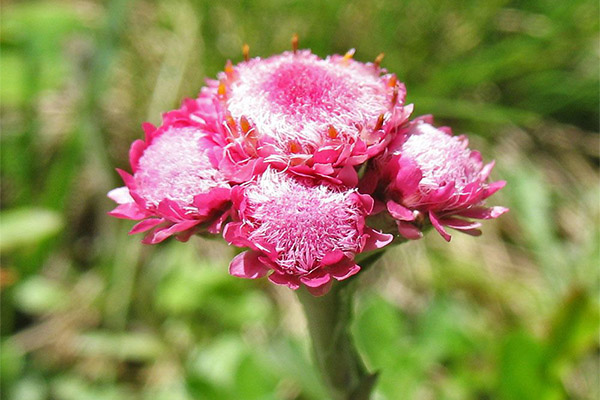
Some believe that by increasing the dose of the drug, they can achieve the maximum therapeutic effect. But this dangerous misconception can lead to serious complications. Therefore, do not risk your health.
Although traditional healers and herbalists offer a huge number of unique recipes with cat-foot grass, many popular remedies are prepared according to the classical scheme. We will tell you how to properly prepare the dosage forms that are most often used for home treatment.
Infusion
According to the classic recipe, the infusion is prepared as follows:
- 1 tbsp pour the flowers with boiling water (0.3 l).
- Leave the composition for 3-4 hours to insist.
- Then strain the solution well.
Take 1 tbsp. with signs of gastric bleeding.
Multiplicity of receptions - every 2 hours.
With nasal bleeding, the solution obtained in this way can be used to plug nasal passages. For bleeding gums, they should rinse your mouth. The composition is suitable for stopping hemorrhoidal bleeding. Only in this case, you need to do lotions with a solution on the anus.
Tincture
Prepared according to the proposed recipe, the product is suitable for both external and internal use. Such a tincture relieves inflammation, stops bleeding. To achieve the maximum therapeutic effect, it is desirable to combine both methods.
Cooking sequence:
- Raw materials in the amount of 1 tbsp. pour 100 ml of vodka.
- Insist composition in a dark and warm place for a week.
- Shake the tincture container regularly.
- Strain the solution before use.
For oral administration, a single dose is 30 drops. It is better to dilute this amount of tincture with water, and then drink it.
For external treatments 1 tsp. tinctures need to be diluted in a glass of water, and then use the resulting solution as intended.
Decoction
It should be noted that decoctions are the most common form of the preparation of healing solutions. In principle, this is a universal tool that is equally suitable for internal reception and external procedures.
Classic Cat Paw Broth Recipe
This drug is useful for those who have problems with blood coagulation. Water tincture is prepared as follows:
- Take 2 tbsp. vegetable powder of antennaria, and pour raw materials with a glass of boiling water.
- Composition put on fire. Boil for 10 minutes. To prevent intense evaporation, cover the dishes.
- After insisting, strain the broth.
Take 2 tbsp. half an hour before meals.
Another recipe popular with healers:
- Pour boiling water over 60–70 g of powder obtained from cat's paw seeds.
- Put the composition on low heat. Bring to a boil, and then remove.
- Let the broth brew for two days, then strain.
The tool is used to treat wounds.
For internal use, the broth is prepared in the same proportions, but instead of seeds, you need to use leaves and flowers. Take the drug inside immediately after preparation. To improve the taste, you can add a little honey.
Addition: decoctions and infusions prepared according to these recipes from the grass of a cat's paw will help normalize the menstrual cycle, get rid of whites, and cure menorrhagia.
Contraindications
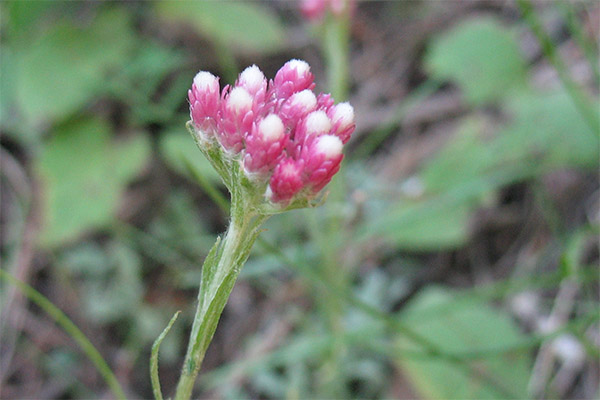
Despite the mass of positive qualities, the cat's foot grass has a number of contraindications. In particular, it is strictly forbidden to take funds from this plant inside:
- during pregnancy and breastfeeding;
- children under 12 years old;
- patients with thrombophlebitis;
- with individual intolerance.
Very carefully, you need to use funds for internal use of hypertensive patients.
The cat's foot has been helping our ancestors for centuries. Healing grass today benefits sick people. For practical use, healers can offer a lot of quite effective recipes, in which the main component is the plant parts of the cat's foot grass. But in this matter it is better to rely on the opinion of experts.
«Important: all information on the site is provided exclusively in fact-finding purposes. Before applying any recommendations, consult with a profile specialist. Neither the editors nor the authors are liable for any possible harm caused materials. "



